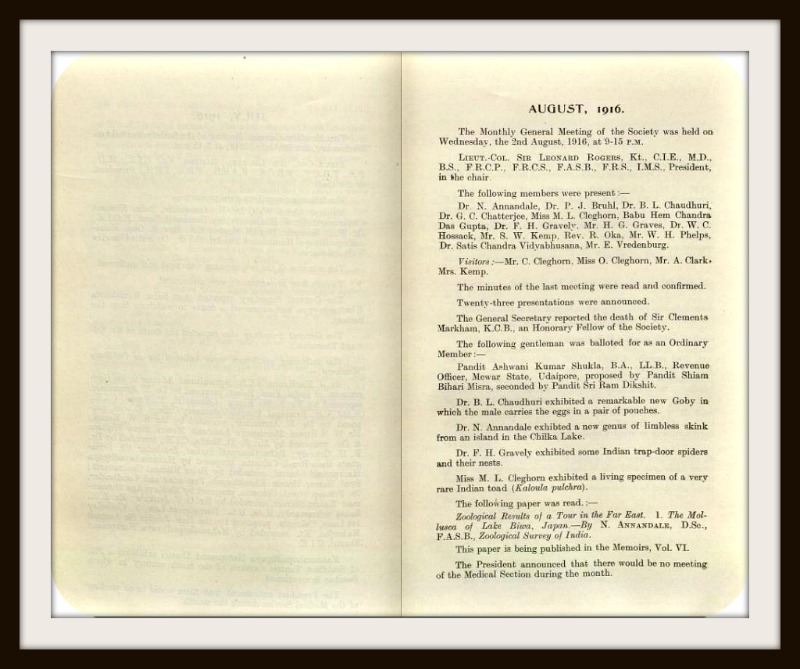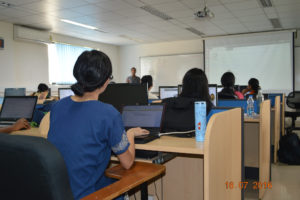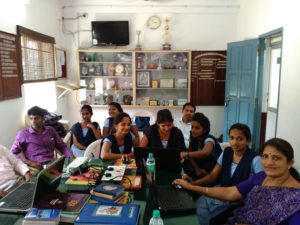Shyamal Lakshminarayanan was on the trail of Maude Lina West Cleghorn, a little-known amateur British entomologist who lived in Calcutta in the early 1900s. Shyamal, an independent researcher and one of India’s most active Wikipedia contributors, had come across references to her while reading about Hugh Cleghorn, one of the pioneers of forestry in India. Shyamal (he prefers to be referred by his first name)’s interest in the female naturalist had also been piqued by his own passion for entomology, or the study of insects — he has authored and edited several Wikipedia articles on insects, such as this one on “ant”.
Shyamal couldn’t find out much about Cleghorn’s personal life in the usual sources — official journals dating back to the 1920s and books on entomology written in that period — but he could see that her work had been meticulous and of a high quality, especially her studies of insect pollination and the longevity of certain insects. It was odd: Cleghorn is a Fellow of the (Royal) Entomological Society, the Linnean Society, and the Zoological Society of London.
Intrigued, he wrote to Lynda Brooks at the Linnean Society of London and Ann Sylph at the Zoological Society of London, requesting them to check their archives for more information on Cleghorn, mentioning that he was planning to write a Wikipedia entry on her. The information available was limited: Brooks wrote back to say that while she had been able to confirm that Cleghorn had indeed been elected a Fellow of the Linnean Society (named after Carl Linnaeus, the father of the scientific system of naming all living beings, a system still in use) on December 4, 1913, and that she had been nominated by Isaac Henry Burkill (Director of the Botanic Gardens, Singapore); David Hooper (Economic Botanist to the Botanical Survey of India); and Lawrence Lewton-Brain (Director of Agriculture, Federated Malay States). Brooks was also able to dig up some scattered information such as her address in Calcutta and an obituary in the Journal and proceedings of the Asiatic Society of Bengal, following her death in 1946. “I’m afraid we have no portrait and no manuscript material,” wrote Brooks to Shyamal.

The trail went cold, and although Shyamal had perhaps shown more interest in this long-dead amateur naturalist than anyone else in over 50 years, he did not have enough information to merit a Wikipedia entry. “Bad luck… sometimes I am forced to relegate my research to my blog… because there is no chance that it can survive on Wikipedia if there are not enough sources to cite,” he says. His post on Cleghorn can be read here.
Minding the gender gap in Wikipedia
It is a well-known fact that women in fields like science, technology, computing, sport, and even writing are under-represented on Wikipedia. Although such assessments are largely subjective, it is common to find substantial articles on male scientists and achievers who are far less significant than female achievers in the same field, while the latter are completely absent from Wikipedia’s pages. Articles on women scientists also tend to be largely written from a male-centric point of view, such as linking back to her male colleagues or co-workers, while such courtesy is hardly extended to the female counterparts.
The overwhelming reason for this is most WIkipedia editors and contributors are male — and when I say ‘most’, I mean more than 90%.
In fact, Wikipedia itself has taken note of this. “It is among the most frequent criticisms of Wikipedia, and part of a more general criticism about systemic bias in Wikipedia. The Wikimedia Foundation, which runs Wikipedia, agrees with this criticism and has made an ongoing attempt to increase female editorship of Wikipedia,” the Wikipedia page titled ‘Gender Bias on Wikipedia’ notes.
The overwhelming reason for this is most WIkipedia editors and contributors are male — and when I say ‘most’, I mean more than 90%.
One of the attempts involves ‘Women’s History Month’, which is celebrated around the world in March, and is marked by Wikipedians everywhere by organising edit-a-thons and workshops. Since 2013, these events have been conducted in India as well, spearheaded by veteran Wikipidians such as Rohini Lakshané, currently working as a program officer on the Pervasive Technologies Project at the Centre for Internet and Society (CIS), and Bishakha Datta, a well-known film-maker and journalist who was appointed as the first Indian board member of the Wikimedia Foundation in 2010 (she served till 2014).
Creating lasting change in any culture is an ongoing process, and while Lakshané and Datta are still active in some projects aimed at reducing the gender gap in Wikipedia, a new generation of activists has also got involved in projects that aim to create better gender parity in the mammoth online encyclopaedia — both in terms of the number of female editors as well as the number of pages dedicated to women achievers.
One of the most successful projects to have come out of the ongoing efforts since 2013 is the Wikipedia Women in Science project organised by IndiaBioscience, a non-profit organisation within the National Centre for Biological Sciences (NCBS) that aims to increase the visibility of science in society by being a hub for policy discussions and science communication. IndiaBioscience has been organising a series of public events — workshops and edit-a-thons — to raise the profile of women scientists in Wikipedia. The edit-a-thons usually encompass a short tutorial on editing Wikipedia, an informal interaction over tea/coffee with a woman scientist, and participants creating and completing Wikipedia profiles of women Indian scientists, working alone or in groups.
Experienced Wikipedia editors like Shyamal have also been a part of these events, to help attendees go through the process of creating articles and correctly fulfilling Wikipedia’s strict criteria for inclusion.

While there were two events in 2014 in Bangalore, in 2015 there was an online event, and in July this year, one of the biggest gatherings took place at the Indian Institute of Science (IISc) campus, says Harini Barath, Program Manager (Science Communication), IndiaBioscience, and one of the organisers of the edit-a-thons. There might be another event in October, and they plan to involve college students, Barath says.
But what’s actually been achieved through these events, besides raising awareness about the crying lack of attention given to female Indian scientists? “When we started, many of the Wikipedia pages for women scientists were stubs,” says Barath. These included articles on prominent and well-known scientists such as sociologist and anthropologist Irawati Karve, botanist E.K. Janaki Ammal, and chemist Asima Chatterjee (these scientists now have robust pages, thanks in part to their inclusion in an influential book, Lilavati’s Daughters, an anthology of biographical essays of Indian women scientists published in 2008 by the Indian Academy of Science, Bangalore). In fact, Lilavati’s Daughters also inspired a separate edit-a-thon in August 2013, during which many of the scientists’ profiles on Wikipedia were edited and updated, and many were translated into Indian-language Wikipedia articles.
“When we started, many of the Wikipedia pages for women scientists were stubs,” says Barath.
Since 2014, the India Bioscience edit-a-thons have, in some way, been carrying this work forward. They started with a list of names of women scientists whose pages had to be added or updated, and over the next few events, more than 50 new articles of varying length and detail have been created by volunteers. When they were making the list, there were names that were missing that stood out, says Barath. “These included female scientists at the top level, some who were directors of institutes. Most people in the research community would know about them. But they didn’t have a Wikipedia page,” she adds.
Take neuroscientist Vijayalakshmi Ravindranath, founder Chair of the Centre for Neuroscience, IISc Bangalore, and the Founder Director of the National Brain Research Centre, Gurgaon. She didn’t have a Wikipedia page till 2014, when her profile was added during one of the edit-a-thons organised by India Bioscience. Or take the example of Sanghamitra Bandyopadhyay, the first woman director of the Indian Statistical Institute, and a brilliant computer scientist specializing in computational biology, evolutionary computation, pattern recognition, machine learning and bioinformatics. Her page was created by an extremely prolific editor with the appropriate username ‘Fluent Flux’ in October 2014 as part of the edit-a-thon.
Some of the other scientists whose profiles were created or filled in with details at these events are:
Aditi Pant: An Indian oceanographer. She was a part of the Indian expedition to Antarctica in 1983 and became the first Indian woman to visit Antarctica (along with Sudipta Sengupta).
Bimla Buti: Indian physicist, specializes in the field of plasma physics. She was the first Indian woman Physicist Fellow of the Indian National Science Academy (INSA).
Rashna Bhandari: Head, Laboratory of Cell Signalling at the Centre for DNA Fingerprinting and Diagnostics, Hyderabad.
Shobhana Narasimhan: Professor of Theoretical Sciences and Dean of Academic Affairs at the Jawaharlal Nehru Centre for Advanced Scientific Research in Bengaluru. Her main area of interest is computational nanoscience.
Suniti Solomon: She was an Indian physician and microbiologist who pioneered AIDS research and prevention in India after having diagnosed the first Indian AIDS cases in Chennai in 1985. She founded the Y R Gaitonde Centre for AIDS Research and Education in Chennai. She died in 2015.
You may notice that many of these profiles on Wikipedia do not have images, and Barath says finding the scientists’ photographs is one of the most challenging aspects of the project. Wikipedia has strict rules about image licensing and reuse, and most Indian institutes, which do have profile pages of the scientists, do not explicitly give permissions for reuse under Creative Commons licenses. And unless they do so, editors can’t use these images in their profiles.
The idea of representative power
In 2011, the Wikimedia Foundation conducted a global editor survey, which indicated that only 8.5% of contributors to Wikipedia were women. Not much has changed in the intervening years, and most surveys show that the percentage of female editors and contributors is anywhere between 8.5% and 16% globally.

According to Ting-Yi Chang, a researcher with the University of Toronto who is currently on a one-year internship with CIS in Bengaluru, the same survey showed that in India the percentage of female editors is around 3%. Chang has been studying and writing on the gender gap issue in Wikipedia and other online communities, and her primary role in India is to work with the CIS group Access to Knowledge (“A2K”; funded by the Wikimedia Foundation) to raise awareness of Indic language Wikipedias and the gender gap among editors in India. She says that “access, self-consciousness (for being minority/female), and the idea of representative power are the main barriers in the Indian context.”

“Although one may say that the three barriers can also be imposed on male users, we have to consider the societal setting and how male and female live and think differently,” says Chang. “In terms of access (to required device/facility and internet), it is possible that female members in a family can be denied the access to say, a laptop, when male members enjoy more privileges. At the same time, females are usually more self-conscious about their surroundings when accessing facilities in a public space.” She adds that access to personal leisure time is another factor.
Even outside of Wikipedia, women tend to avoid being “visible” online, and this is by no means an Indian problem, she adds. “We need to ensure a female-friendly place in our communities, and by having more women joining now we are also opening up more opportunities for the future. The idea of representative power means that women need to have the confidence and courage to edit whatever they think they can contribute. Although one may say this is more of a personal mindset problem, we also need to realise that in societies where women are not encouraged to be outspoken and assertive (and again this is not just in India), we tend to refrain from making public statements even when we know that we know better.”
One encouraging fact is that several of the Indian language Wikipedia entries have seen greater women’s participation. Take, for instance, the Tulu language Wikipedia, which went live in August 2016, becoming the 23rd Indic language Wikipedia. There is a fair mix of women among its 200-odd editors, primarily because of the involvement of educational institutions and workshops conducted in colleges, such as St Aloysius College in Mangaluru.
The internet was supposed to be the ultimate leveller — a truly egalitarian zone because men and women had equal access to it from the same time. However, it has developed to become deeply sexist in some ways — more so in certain communities and online groups. Why is the internet not as equal in terms of gender as it could have been?
Chang says that her research on this topic, including reading the works of people like Dr Tanja Carstensen, a sociologist and researcher with the Work-Gender-Technology research group at the Hamburg Institute of Technology, shows that sexism in our online communities is not a product of the internet; it probably should not be counted as a “failure” of the internet either, but it is a reflection of society — an “intensification even, as the anonymity and informality of internet that change the way humans interact with others.”
“In other words, perhaps we have to realise that the internet being patriarchal and unequal is not a surprise, but sadly the default… I see ourselves in the second stage of Carstensen’s summary (internet as platforms of feminist voices and debates) and Wikipedia can be a great catalyst in this movement. We need knowledge based on an equal standard in order to make our online space more aware of its sexism. When the idea of feminism can spread through the internet, through Wikipedia, when people start taking this issue more seriously, there will be more awareness of how the web can and should become for women,” says Chang.
Subscribe to FactorDaily
Our daily brief keeps thousands of readers ahead of the curve. More signals, less noise.








